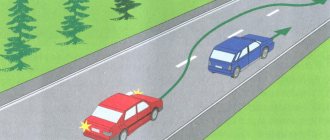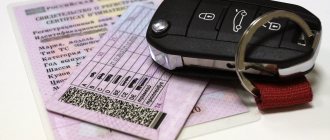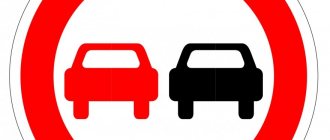The main types of punishment for a “No overtaking” sign
Overtaking in the area covered by the sign can be safe, but often this kind of maneuver in prohibited places is accompanied by great public danger. Authorized employees, after assessing the traffic situation, will hold the motorist accountable according to the following system:
- overtaking in the presence of a prohibitory sign - 5 thousand rubles;
- repeated overtaking in the wrong place - confiscation of the license for 12 months;
- if a violation is recorded by an automatic camera - 5 thousand rubles;
- if a violation is repeatedly recorded using video equipment - 5 thousand rubles.
- making a U-turn or turning left on a section of road that prohibits such maneuvers - 1.5 thousand rubles;
- avoiding obstacles in the sign's coverage area - 1.5 thousand rubles;
- the driver overtook using the side of the road - 1.5 thousand rubles;
- overtaking on a section of the road that is not equipped with markings, but has a prohibitory sign - 500 rubles;
It can be noted that even if a repeated violation is detected automatically, the driver does not risk losing his driver’s license. This is the peculiarity of recording violations using cameras.
○ Where is overtaking prohibited?
Some drivers are sure that you cannot overtake only if you have to cross a solid marking line, in fact, clause 11.4. The traffic rules provide a list of places where overtaking is prohibited:
- “Overtaking is prohibited:
- At signalized intersections, as well as at uncontrolled intersections when driving on a road that is not the main one.
- At pedestrian crossings.
- At railway crossings and closer than 100 meters in front of them.
- On and under bridges, overpasses, overpasses, as well as in tunnels.
- At the end of a climb, on dangerous turns and in other areas with limited visibility.”
If everything is very clear with the ban on overtaking at pedestrian crossings and crossings, then with intersections everything is a little more complicated. In any case, it is prohibited at a controlled intersection.
On an unregulated road, only vehicles moving on the main road can be overtaken, provided that it is not a four-lane road. In this case, it will be marked with special signs 2.1, 2.3.1 - 2.3.7.
As for bridges, you need to be careful. They will not necessarily be marked with special signs, but, nevertheless, you should not overtake under them.
You must not overtake at the end of a steep hill or in a closed corner. They are indicated by signs 1.14, 1.11.1 and 1.11.2.
One of the most difficult issues is overtaking in low visibility conditions, but what is “low visibility”? Clause 1.2 of the Traffic Regulations gives a rather vague definition:
- “Limited visibility” is the driver’s visibility of the road in the direction of travel, limited by the terrain, geometric parameters of the road, vegetation, buildings, structures or other objects, including vehicles.”
Visibility on the road may become limited at any time due to changes in the road situation and the location of vehicles. In such conditions, overtaking becomes an extremely dangerous maneuver, which means it is better to abandon it.
Please note that overtaking along the entire length from the exit from the occupied lane is considered uniform, and therefore it should begin and end only on permitted sections of the road.
And of course, in no case should you ignore the markings when crossing a solid line or “no overtaking” signs. Any of these violations are punishable by a serious fine.
Definition of overtaking in 2021
According to the legislation in force for 2021, overtaking is only considered to be ahead of a passing vehicle, accompanied by driving into the lane of oncoming traffic. This concept should not be confused with ahead or detour. Unfortunately, in the traffic rules, the analysis of each definition is presented very vaguely, which raises many questions in controversial situations.
Overtaking is the act of avoiding a car ahead using a lane of passing traffic. The difference in the concepts of “ahead” and “overtaking” is only that when overtaking, the driver uses the oncoming lane. Detour is the process of overcoming a stationary obstacle located on the road.
What do you mean by overtaking?
According to current legislation, the concept in question is clearly separated from similar situations related to passing another vehicle. Overtaking is a maneuver accompanied by driving into oncoming traffic (Section 1.2 of the Traffic Regulations). Advancement within the framework of its direction will not be considered as such. In this case, after the maneuver, the driver is obliged to move out of the oncoming lane on the roadway, which is called an oncoming lane among motorists. Otherwise, he may be fined.
The rules for overtaking while entering oncoming traffic do not allow dangerous maneuvers in all situations. However, it will be possible to get ahead of a vehicle in the zone of such restrictions without violating traffic rules.
What is the difference between overtaking and ahead?
According to the current rules governing the responsibilities of road users, the main factor is driving into oncoming traffic. This is what is considered the most dangerous maneuver, due to which people most often die. The established restrictions are designed to reduce accident rates and increase the comfort and safety of overtaking, which differs from ahead in that it always involves entering the oncoming lane.
In what cases is overtaking prohibited 2021
A sign prohibiting overtaking maneuver is usually installed outside the city. On a suburban highway, the owner of a vehicle may receive a serious fine when overtaking in the coverage area of sign 3.20 (“Overtaking is prohibited”).
On highways with high speed limits, the likelihood of an accident occurring when overtaking with the help of oncoming traffic increases significantly. When overtaking at high speeds, there is a high probability of death in the event of an accident. For this reason, the authorities are trying to strictly control cases of illegal entry into the oncoming lane in the area covered by sign 3.20.
Outside the city, traffic officers often set up various “traps” and “ambushes” to catch offenders. For this kind of disregard for traffic rules, the driver may well lose his driver's license.
If a motorist has entered the coverage area of sign 3.20, he must remain in the lane of passing traffic. The restriction will be lifted only when the overtaking prohibition sign expires, which can begin in several cases:
- The driver has already covered the distance indicated on the sign (overtaking is prohibited only for the indicated duration of the road);
- The motorist crossed a sign stating that sign 3.20 has been cancelled;
- The owner of the vehicle has reached a populated area;
- The driver has crossed a sign canceling all possible restrictions (3.31);
- The motorist reached the intersection and drove through it.
It is worth noting that on intercity highways, signs prohibiting overtaking are installed in places with high accident rates. Thus, overtaking is prohibited at the end of slopes, at the beginning of sharp turns and in areas with limited visibility.
Where maneuver is allowed
Outside a populated area, a motorist has the right to overtake in the following areas:
- if the roadway consists of two lanes that are separated by dotted markings;
- on a highway with combined marking lines on the asphalt;
- in a three-lane traffic zone with intermittent markings.
But there are also restrictions under which overtaking even in this area will be unacceptable. This applies to visibility conditions and the presence of signs. In addition, the driver must understand what he is risking. Before the maneuver you should make sure:
- road condition that meets safety requirements;
- serviceability of the vehicle;
- sufficient level of driver skills.
Read also: What fine must be paid for late registration of a car in 2021
The rules provide for specific conditions under which the maneuver cannot be performed.
Where is it prohibited to overtake?
Actions that cannot be performed if you want to get ahead of a vehicle in the oncoming lane are clearly stated (Section 11.4 of the Traffic Regulations).
- In cities and outside populated areas, overtaking is not allowed in the intersection area. The maneuver is permitted only if you are driving on the main road and in the absence of traffic lights.
- Overtaking on the right across the side of the road is prohibited.
- The maneuver is unacceptable at pedestrian zebra crossings and in the 100-meter section before and after the railway crossing.
- Another ban concerns complex engineering structures: tunnels, bridges, and so on. The danger of the maneuver in this case increases due to visibility conditions. It is important to note that the driver will receive a fine for overtaking on the bridge even if he overcomes a traffic jam or an accident.
- You should not take risks on climbs, sharp turns, or in the area of the winding route. The listed areas are marked with a sign prohibiting overtaking (3.20). It can usually be found on the most dangerous parts of the road, so an inexperienced driver is advised to concentrate and slow down when he sees such a sign.
- Violating the “No Overtaking” sign without a continuous marking line will also result in a fine, since the first one has priority over the second.
A number of additional restrictions are established by clause 11.2 of the Traffic Regulations. Overtaking is prohibited if:
- another car is already performing the maneuver behind;
- similar actions are taken by the vehicle behind which the driver’s car is traveling;
- the signal about the intention to start overtaking is already given by the vehicle in front;
- the maneuver may not be completed due to obstacles or oncoming vehicles.
Liability for violating overtaking rules depends on the severity and circumstances of the specific offense. In any case, it will be significant.
In what cases is overtaking prohibited without a sign 2021
In special areas of vehicle traffic, drivers must be aware of the situation and not allow themselves to make dangerous maneuvers. Thus, overtaking is prohibited in the following areas that are not equipped with the appropriate sign:
- at a controlled intersection;
- at an uncontrolled intersection if the driver is moving on a secondary road;
- at pedestrian crossings where there are less protected road users - pedestrians;
- directly at the railway crossing and closer than a hundred meters in front of it;
- on and under bridges;
- on overpasses;
- on overpasses;
- in the tunnels.
The restrictions on overtaking are in effect due to the increased danger of objects. Thus, at pedestrian crossings, drivers may often not notice those crossing the road. Bridges and overpasses are not always reliable in design and sometimes cannot provide a high level of safety.
It is important to pay attention to other circumstances that prevent safe overtaking. The maneuver is strictly prohibited in the following cases:
- the vehicle in front has not yet completed overtaking;
- the vehicle following the car has begun to overtake;
- The driver in front turned on his turn signal.
Also, overtaking is strictly prohibited if the driver is not convinced that the maneuver being performed is safe.
Penalty for overtaking
The fine for overtaking in the wrong place is established based on the rules provided for in Art. 12.15 Code of Administrative Offences. Unauthorized driving into oncoming traffic is punishable by a ruling of 5,000 rubles or deprivation of rights for a period of 4-6 months. For a repeated offense, the driver's license may be taken away for a year. When overtaking is recorded by a camera, the fine will be 5,000 rubles without deprivation.
If a driver is caught by traffic police inspectors while overtaking, if there is a temporary sign prohibiting this, the liability will be the same, regardless of the markings. Such designations, according to traffic regulations, have priority.
Read also: What is the fine for an “unbelted” driver or passenger in 2021
At the crossroads
In such a case, the punishment depends on the provision of traffic lights at the road intersection. The fine for overtaking at an intersection is 5,000 rubles. However, if the driver maneuvers on the main road at an unregulated intersection, he will not receive a ticket.
The described action is prohibited under any circumstances if there is a traffic light. Overtaking at a controlled intersection is very dangerous, because it is unlikely that other road users will be able to predict this.
Sometimes during traffic jams, motorists try to drive through intersections in the pedestrian zone. In this case, what fine the violator will receive for driving on the sidewalk is also established by Art. 12.15 Code of Administrative Offences. He will be charged 2,000 rubles.
At a pedestrian crossing
Previously, if there were no people on the zebra crossing, cars could overtake it with impunity. According to current rules, this is prohibited, since visibility conditions do not always allow the car owner to detect a person in time and prevent an accident involving a pedestrian.
Cameras are now monitoring compliance with the restrictions. However, despite the fact that the Code of Administrative Offenses in 2021 provides for a fine or deprivation of driving license for overtaking at a pedestrian crossing, information from means of automatic detection of offenses can only lead to the imposition of a monetary penalty.
Under the "No Overtaking" sign
If you ignore such designations, the driver will have to forget about driving his “iron horse” for six months or pay 5,000 rubles. The fine for overtaking under the sign “Overtaking is prohibited” in 2021 is imposed without leniency, because it is installed in the most dangerous places where it has already happened There are many fatal accidents. By breaking the rules, the driver will risk not only his life, but also the health of bona fide road users.
Who can you overtake in the area of the “No Overtaking” sign?
The legislation provides for the possibility of overtaking certain types of transport in the coverage area of sign 3.20. According to the traffic rules, after passing the “overtaking is prohibited” sign, drivers have the right to get ahead (using the oncoming lane) of the following types of vehicles:
- mopeds;
- motorcycle (without sidecar);
- vehicles equipped with a “slow-moving vehicle” sign;
- horse-drawn carts.
In practice, it is better to refrain from overtaking slow-moving vehicles that are not equipped with the appropriate sign. Even if the vehicle’s speed is less than 30 km/h (which, by definition, qualifies tractors, combines and other equipment as low-speed vehicles), it will be difficult for government officials to prove the legality of their actions.
Regarding mopeds, motorized vehicles and horse-drawn vehicles, the rules remain unchanged. It is better to wait until the end of the prohibited overtaking zone and perform the maneuver in accordance with the traffic rules. However, there are cases when the lifting of the restriction is still far away, but there is no time. In such situations, you can ask the driver of the slow-moving vehicle to pull over to the side of the road using a sound or light signal.
There is an effective way to avoid punishment when overtaking slow-moving vehicles. The motorist must wait until the slow-moving vehicle is overtaken by other road users. Often, traffic police officers stop only the first offenders and ignore subsequent ones.
What is the punishment?
Sanctions for crossing a solid marking line in order to get ahead of another car are regulated by part 4 of article 12.15 of the Code of Administrative Offenses. Depending on the degree of public danger of the act, the driver’s liability is determined.
According to the provisions of the law, the motorist will face a financial penalty in the amount of 5 thousand rubles. A similar fine is provided for when driving onto tram tracks in the opposite direction. The large amount is argued by government officials that overtaking in the area covered by a prohibiting sign is a dangerous offense that can lead to a serious accident.
There are also exceptions to the general rule, specified in part three of Article 12.15 of the Code of Administrative Offences. According to this regulation, under aggravating accompanying circumstances, a motorist may lose his license for a period of 4 months to six months. If the violation is repeated within a year - for 12 months.
Responsibility for non-compliance with the rules
In accordance with the Code of Administrative Offenses of the Russian Federation, liability is provided for each situation related to the creation of an emergency traffic situation.
For entering the lane of oncoming traffic on tram rails in the presence of a situation that allows you to go around an obstacle on the right side, a penalty of 1000-1500 rubles is provided.
Crossing a solid line within the coverage area of a sign prohibiting overtaking will entail an administrative penalty in the amount of 5,000 rubles. and a ban on driving with the confiscation of the license for a period of 4-6 months.
For repeated overtaking, a fine is imposed in the form of deprivation of the right to drive a vehicle for a period of 1 year. If there are no road markings and a maneuver is made in the center of the roadway, a fine of 500 rubles is provided.
If a violation of overtaking rules is recorded using road video recorders, which in other cases provide for punishment by deprivation of the right to drive a vehicle for 12 months, an alternative fine of 5,000 rubles will be imposed.
Penalty for temporary index
Temporary signs are set on a non-permanent basis. They have a distinctive yellow-orange background, making the sign hard to miss. However, drivers do not always have an idea of whether it is necessary to follow the instructions of the temporary sign.
It is important to know: if the requirements of temporary and permanent signs contradict each other, motorists should be guided by the instructions of the portable signs. The explanation for this is simple: it is easier for authorities to install a temporary sign than to replace permanent ones.
Thus, liability for overtaking in the area of effect of a temporary sign prohibiting overtaking does not differ from liability for violations of the requirements of a permanent sign. The amount of the fine will also be 5 thousand rubles.
Traffic rules
The cases in which overtaking is prohibited are discussed in paragraph 11.4. Rules Thus, it is forbidden to overtake a vehicle entering oncoming traffic at:
- controlled intersections;
- unregulated if the driver is moving on a secondary road;
- crossings intended for pedestrians;
- railway transport crossings;
- bridges;
- dangerous turns and other areas with low visibility.
Also clause 11.2. The Rules prohibit overtaking if:
- the vehicle ahead has already started this maneuver or has given a corresponding signal with a turn signal;
- the vehicle behind began to overtake;
- there is no adequate degree of confidence that the maneuver will be completed safely.
Please also note that in Section 9 of the Rules “Location of vehicles...” you can read about in which cases driving into oncoming traffic is generally prohibited (even if there are no markings or signs prohibiting overtaking). So, for example, clause 9.2. prohibits entering oncoming traffic in any case if the road has 4 or more lanes for traffic in each direction.
No markings
If there are no markings on the section of road where the driver decided to overtake, the driver may inadvertently “cross” a non-existent solid road. Often such situations occur on small roadways, the width of which does not exceed 5 meters.
Similar cases are recorded in part one of Article 12.16 of the Code of Administrative Offenses of the Russian Federation. According to the law, the fine will be 500 rubles. Nevertheless, road inspectors often try to deprive the driver of the right to drive a vehicle.
If a traffic police officer attempts to confiscate a license on an unlawful basis, the motorist must defend his position. To make a competent appeal, you need to study the legislation and refer to its appropriate provision. Usually, if there is a categorical refusal to consider the arguments of the accused, the driver turns to the judicial authorities.
During the legal proceedings, the owner of the vehicle has every chance of canceling the protocol. It is only important to collect all the relevant evidence and present it correctly to the court. A sufficient basis for reclassifying the violation will be video material from the recorder. If the case is successfully completed, the motorist will reduce the penalty to 500 rubles.
Avoid obstacles under the sign
In paragraph 1.2 of the traffic rules, an obstacle is any stationary object or defect in the roadway that prevents a car from passing along the occupied lane. In such cases, the driver is forced to change lanes into oncoming traffic. It is important to note that a vehicle stopped at a traffic light is in good working order or is not considered an obstacle.
Often, road inspectors do not understand the situation and equate any crossing of a solid marking line with part four of Article 12.14 of the Code of Administrative Offenses. Crossing a continuous line within the coverage area of sign 3.20 is sanctioned by a fine of 5 thousand rubles or deprivation of a driver’s license for up to six months.
Some motorists, in a state of shock, agree with all the charges. However, it is important to objectively assess the situation. If the driver can prove in court that he was forced to drive into the oncoming lane within the coverage area of sign 3.20, the penalty will be reduced to 1,500 rubles.
Thus, the driver can only reduce the degree of responsibility for crossing solid markings. The only sure way to avoid a fine is to stop. Only if the motorist stops driving and waits for the obstacle to be eliminated, traffic police inspectors will not be able to bring him to financial penalties.
In addition to the provisions of the law, the owner of the vehicle should familiarize himself with the responsibilities of road inspectors. Thus, Article 49 of Order 185 of the Ministry of Internal Affairs of the Russian Federation obliges traffic police inspectors to take measures to eliminate obstacles that arise on the road. The motorist has the right to point out this fact if the authorized officer decides to issue a fine for hitting a solid line while passing.
Rules for overtaking on the road
This maneuver is one of the most dangerous, so the driver must be confident in his abilities. Overtaking is carried out according to the algorithm described below.
- First of all, you need to make sure (using the mirrors) that no one behind you has already changed lanes into the oncoming lane.
- Next, you should evaluate the road situation: visibility area, distance to possible obstacles and cars traveling in the opposite direction.
- If nothing prevents you from overtaking, you should sound the left turn signal.
- Then you can change lanes into oncoming traffic by returning the light signal switch lever to the neutral position. The maneuver should be performed while maintaining a distance from the vehicle being overtaken in order to clearly see the road and have time to return when cars appear.
- In the oncoming lane, you need to accelerate as quickly as possible and return to your section of the roadway, turning on the right turn signal. However, you cannot taxi while cutting off an overtaken vehicle.
Read also: Fine for driving a car without documents: STS, OSAGO and VU
Traffic regulations prohibit changing lanes outside the roadway and overtaking on the right. The violator will be issued a fine for driving on the side of the road.
Overtaking on the side of the road
Sometimes drivers resort to overtaking using the side of the road, believing that this way they can avoid punishment. However, this is an incorrect assumption. The shoulder is the same element of the road as the roadway. Only pedestrians, horse-drawn vehicles and some two-wheeled vehicles are allowed to travel through this area.
The administrative measure in this case is a fine of 1,500 rubles. This measure is provided for in part one of Article 12.15 of the Code of Administrative Offenses of the Russian Federation. It is worth noting that a similar measure of enforcement will be applied for any illegal driving to the side of the road (even without the purpose of overtaking).
In case of emergency, motorists can resort to one of the omissions in the legislation. The traffic rules state that drivers have the right to use the side of the road to stop or park. However, the rules do not specify the maximum distance a driver can drive before coming to a complete stop.
You can also avoid penalties in this way: a motorist must stop periodically when driving on the side of the road. From a legislative point of view, these actions are regarded as choosing the most suitable situation for returning to the roadway.
U-turn instead of overtaking
The owner of a vehicle can avoid administrative penalties if, instead of overtaking, he makes a U-turn or a turn. If, at the time of performing a prohibited maneuver, the driver detects traffic police inspectors, he can “accidentally” change the trajectory of his movement by entering the adjacent territory or turning. The driver's actions will not be considered overtaking if he does not return to his lane.
A fine in such a situation is still possible. However, the risk of losing your rights will remain behind. When crossing a solid road while turning or turning, the inspector has the right to impose a fine only in the amount of 1,000 to 1,500 rubles.
It is important to consider that turning around without assessing the traffic situation can lead to consequences more serious than a fine of 5,000 rubles. It is important to change the trajectory only with full confidence in the safety of the situation.
Overtaking caught on camera
Offenses recorded by photographic or video equipment are sanctioned by the state with a fine in the amount of 5 thousand rubles. In such situations, the owner of the vehicle receives a copy of the protocol by mail, to which is attached photo evidence of the administrative offense committed.
Evidence of the driver’s guilt in the form of a photograph is difficult to appeal. However, automatic registration of illegal overtaking can be considered a success. If a traffic inspector takes care of the registration of an offense recorded on camera, the motorist risks losing his driver’s license altogether.
It is quite difficult to appeal a fine from a camera issued by a traffic police officer. In addition to the fact that the prosecutor has clear evidence of the motorist’s guilt, the court often takes the inspector’s side. Due to the fact that the employee is a representative of law and order, the judge rejects the appeal, citing the lack of reasons not to believe the traffic police inspector.
Repeated violations under the sign “Overtaking is prohibited”
Part four of Article 12.15 regulates: a second violation of traffic rules within a year entails deprivation of rights for a period of 12 months. This provision is also valid in the case when the driver overtakes in the wrong place for the second time in a year.
It is important to take into account the changes that came into force in 2019. According to the new requirements, a motorist will not be able to regain the right to drive a vehicle without passing the exam. If previously you could simply submit a corresponding application to return your ID, now you will have to repeat the traffic rules.
Attempts to pass the exam after a year of deprivation of rights due to repeated violation of overtaking norms are provided in an unlimited number. However, after failing the test, a motorist can try again only after a week's break. Also, you can start testing only after the expiration of the one-year period for deprivation of the certificate.
Is it possible to reduce the amount of the fine?
Changes in 2021 also affected the ability of vehicle owners to pay fines for overtaking in the area covered by a prohibiting sign. Now motorists cannot save money if they pay the amount within 20 days of receiving the order.
The discount for paying a fine has also ceased to be provided for the following types of traffic violations:
- the driver exceeded the permissible speed limit by 40 kilometers per hour or more;
- the motorist operated the vehicle while under the influence of alcohol or drugs;
- the owner of the vehicle caused an accident due to violation of traffic rules;
- a person uses a car without appropriate registration;
- The motorist ran into a prohibitory traffic light.
Thus, overtaking with a prohibitory sign is not the only violation in which payment of a fine in the first 20 days is not accompanied by a 50% discount. The owner of the vehicle is forced to either pay the fine or use public transport for a year.
The motorist must carefully monitor the road situation and avoid violations unless absolutely necessary. Overtaking should only be done under favorable circumstances. It is important to remember that in the event of an accident, the driver will bear full responsibility for the damage caused.











